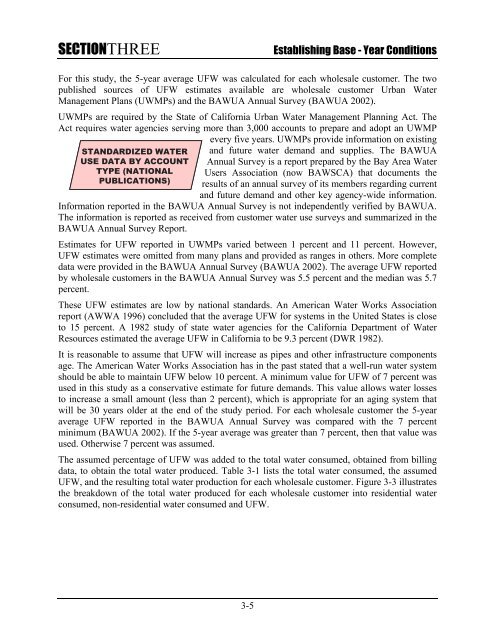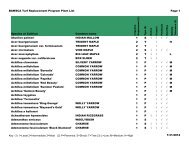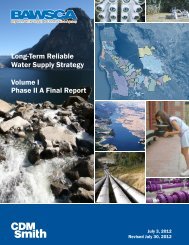SFPUC Wholesale Customer Water Demand Projections ... - BAWSCA
SFPUC Wholesale Customer Water Demand Projections ... - BAWSCA
SFPUC Wholesale Customer Water Demand Projections ... - BAWSCA
Create successful ePaper yourself
Turn your PDF publications into a flip-book with our unique Google optimized e-Paper software.
SECTIONTHREE<br />
Establishing Base - Year Conditions<br />
For this study, the 5-year average UFW was calculated for each wholesale customer. The two<br />
published sources of UFW estimates available are wholesale customer Urban <strong>Water</strong><br />
Management Plans (UWMPs) and the BAWUA Annual Survey (BAWUA 2002).<br />
UWMPs are required by the State of California Urban <strong>Water</strong> Management Planning Act. The<br />
Act requires water agencies serving more than 3,000 accounts to prepare and adopt an UWMP<br />
every five years. UWMPs provide information on existing<br />
STANDARDIZED WATER<br />
USE DATA BY ACCOUNT<br />
TYPE (NATIONAL<br />
PUBLICATIONS)<br />
and future water demand and supplies. The BAWUA<br />
Annual Survey is a report prepared by the Bay Area <strong>Water</strong><br />
Users Association (now <strong>BAWSCA</strong>) that documents the<br />
results of an annual survey of its members regarding current<br />
and future demand and other key agency-wide information.<br />
Information reported in the BAWUA Annual Survey is not independently verified by BAWUA.<br />
The information is reported as received from customer water use surveys and summarized in the<br />
BAWUA Annual Survey Report.<br />
Estimates for UFW reported in UWMPs varied between 1 percent and 11 percent. However,<br />
UFW estimates were omitted from many plans and provided as ranges in others. More complete<br />
data were provided in the BAWUA Annual Survey (BAWUA 2002). The average UFW reported<br />
by wholesale customers in the BAWUA Annual Survey was 5.5 percent and the median was 5.7<br />
percent.<br />
These UFW estimates are low by national standards. An American <strong>Water</strong> Works Association<br />
report (AWWA 1996) concluded that the average UFW for systems in the United States is close<br />
to 15 percent. A 1982 study of state water agencies for the California Department of <strong>Water</strong><br />
Resources estimated the average UFW in California to be 9.3 percent (DWR 1982).<br />
It is reasonable to assume that UFW will increase as pipes and other infrastructure components<br />
age. The American <strong>Water</strong> Works Association has in the past stated that a well-run water system<br />
should be able to maintain UFW below 10 percent. A minimum value for UFW of 7 percent was<br />
used in this study as a conservative estimate for future demands. This value allows water losses<br />
to increase a small amount (less than 2 percent), which is appropriate for an aging system that<br />
will be 30 years older at the end of the study period. For each wholesale customer the 5-year<br />
average UFW reported in the BAWUA Annual Survey was compared with the 7 percent<br />
minimum (BAWUA 2002). If the 5-year average was greater than 7 percent, then that value was<br />
used. Otherwise 7 percent was assumed.<br />
The assumed percentage of UFW was added to the total water consumed, obtained from billing<br />
data, to obtain the total water produced. Table 3-1 lists the total water consumed, the assumed<br />
UFW, and the resulting total water production for each wholesale customer. Figure 3-3 illustrates<br />
the breakdown of the total water produced for each wholesale customer into residential water<br />
consumed, non-residential water consumed and UFW.<br />
3-5







